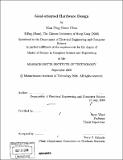Goal-oriented hardware design
Author(s)
Chau, Man Ping Grace
DownloadFull printable version (24.93Mb)
Other Contributors
Massachusetts Institute of Technology. Dept. of Electrical Engineering and Computer Science.
Advisor
Steve Ward.
Terms of use
Metadata
Show full item recordAbstract
This thesis presents Fide, a hardware design system that uses Goal-oriented programming. Goal-oriented programming is a programming framework to specify open-ended decision logic. This approach relies on two fundamental concepts-Goals and Techniques. Goals encode decision points and Techniques are scripts that describe how to satisfy Goals. In Fide, Goals represent the functional requirements (e.g., addition of two 32-bit binary integers) of the target circuit. Techniques represent hardware implementation alternatives that fulfill the functions. Techniques may declare their own subgoals, allowing a hierarchical decomposition of the functions. A Planner selects among Techniques based on the Goals declared to generate an implementation of the target circuit automatically. Users' preferences can be added to generate circuits for different scenarios: for different hardware environments, under different circuit constraints, or different implementation criteria etc. A Beta processor is implemented using Fide. The quality of the implementation is comparable to those optimized manually.
Description
Thesis (S.M.)--Massachusetts Institute of Technology, Dept. of Electrical Engineering and Computer Science, 2008. Includes bibliographical references (p. 145-146).
Date issued
2008Department
Massachusetts Institute of Technology. Department of Electrical Engineering and Computer SciencePublisher
Massachusetts Institute of Technology
Keywords
Electrical Engineering and Computer Science.